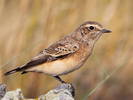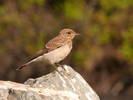search
classification
|
basic information
|
video
|
reports |
Pied Wheatear
Oenanthe pleschanka (Lepechin, 1770)

|
 male
|
|
|
2014-05-07
Jodro, Altai Republic. |
© Sergey Pisarevskiy
|
|
Description
The Pied Wheatear is a little bird a few lesser than Northern Wheatear. In spring and summer the male is a white and black bird. The white crown tinged with grey contrasts with the black face and throat. The wings and back are black also. The female is browner and has dark brownish head, breast and wings distinguished it on the lighter and more rufous females of other Wheatears. Also females look smaller than other Wheatears and showed less white on the rump. The tail and rump are white, with an inverted black T giving a pattern. After summer (on July-August) molting male has rufous-brownish crown, fresh feathers both black and white have rufous tips but the male remains easily recognized. Autumn female also have on the back the rufous tone formed by light tips of fresh feathers. Juveniles in first plumage have light spots on the back and dark pattern on the breast. Autumn females and juveniles distinguish on other wheatears by the tail having slim less than quarter of tail's length dark terminal band. Weight 15-22 grams, length 15-18, wing 8,6-10,1, wingspan 26-30 cm.
Biology
Pied Wheatear is common, in places abundant breeding migrant. It inhabits the open hill countries such as stony foothills, dry low mountains with rocks and scarce vegetation to 1900-2000 m in Altai and 2800-3000 m in Tien Shan; on the plains it prefer the combing countries with constructions, banks or clay precipices. These countries are used by Pied Wheatear on migration too. It appears on the mid–end March in southern parts of the range, and on April – early May in northern ones and in highlands. Intense migration recorded in April usually in loose groups of 10-15 birds. Pied Wheatear breeds in separate pairs not far one from another. The nest is built under the stones, in the rock cracks, in the clay holes, under the roof and in the wall break of buildings, rare in the burrows. Sometimes nest is in vertical split and is open from above. Usually the nest can be touched and it is rare happens on the depth more than 30 cm. The female builds the cup-shaped nest from dry grass and lines it with thin grass, shrub bast, but most hairs. Only female builds it, male escorts her. Clutches of 4-6 eggs is in the second half of April – mid-June. Only female incubates for 13 days. Both parents feed juveniles which fledge in the mid-May – early August. Two broods per season are probable; the second breeding after losing of the first nest is common. The autumn migration starts in August when the birds leave highlands, on the plains the majority of birds migrates in September. The latest migrants recorded in the end October on Chokpak Pass.
References













